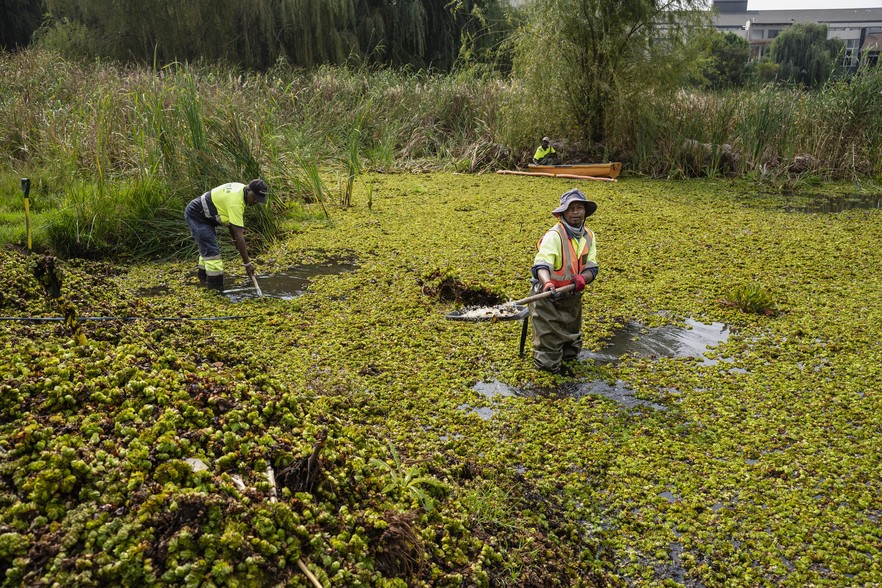
11 April 2025
Workers from the Lonehill Community Improvement Initiative trying to remove invasive Kariba weed from the dam in Lonehill Park in Johannesburg. Photos: Ihsaan Haffejee
Once thriving with aquatic life, two dams in the north of Johannesburg are now completely blanketed by a thick, green invasive plant species.
The Salvinia Molesta, more commonly known as Kariba weed, is an invasive species of free-floating water fern from Brazil. The plant has spread over the surface of the dams in the Lonehill public park and nearby Witkoppen Spruit Park and is clogging up waterways.
The water fern settles on slow-moving or stagnant water, forming dense mats of up to 50cm thick, covering the surface of the water and blocking oxygen, threatening indigenous aquatic life.
Researchers have ranked the Kariba weed second only to water hyacinth on a list of the world’s most problematic aquatic weeds.
The thick vegetation also serves as breeding grounds for mosquitoes and bilharzia-carrying snails, according to signs put up by Johannesburg City Parks at the Lonehill dam.
Researchers have ranked the Kariba weed, second only to water hyacinth, on a list of the world’s most problematic aquatic weeds based on its impact on the environment and on livelihoods. Its impact on larger water bodies such as Lake Ossa in Cameroon, has been significant.
Invasive species are controlled by the National Environmental Management Biodiversity Act which divides species into four categories. The Kariba weed falls under Category 1b described as an “invasive species which must be controlled, and wherever possible, removed and destroyed. Any form of trade or planting is strictly prohibited”.
Local ward councillor David Foley says he is working with City of Johannesburg authorities to find a sustainable solution to the problem of the invasive species.
Ward councillor David Foley said residents noticed the rapid growth of the Kariba weed late last year. At first they tried to remove the plant themselves but the fern only grew back thicker and spread across the dam, says Foley.
He says they contacted Johannesburg City Parks officials, who allocated a portion of the budget to help remove the Kariba weed. “In January, around ten guys arrived with a small rowboat. They claimed they could remove everything in just a few hours. They ended up working for two weeks, trying to remove this stuff manually, but you couldn’t even see a difference because it grows back so thick and fast.”
Foley says that City Parks told them after two weeks the budget was used up.
Meanwhile Lonehill residents, through the Lonehill Community Improvement Initiative, have employed workers to clean the dam, but the weed is hard to eradicate.
An aerial view of the dam at the Witkoppen Spruit Park which shows it fully covered by the weed.
“We have to think of a sustainable solution otherwise the invasive species will just keep returning, because we have an issue of high nutrients in the water due to things like sewer leaks into our river systems,” said Daniel Masemola, director of Water Management and Biodiversity at the City of Johannesburg.
He suggested using a weed harvester and then introducing biological control in the form of water hyacinth planthopper, a tiny insect that feeds on the invasive species and eventually kills it.
A worker with the Lonehill Community Improvement Initiative rows his boat through the thick layer of weed.
The Kariba weed multiplies fast in nutrient-rich waters such as those polluted by wastewater.
Sewage has recently leaked into the dam at Lonehill after heavy rains.
Foley said that he is working with the relevant authorities at Joburg Water to ensure that sewage leaks are fixed promptly.
Gugu Zondi, Manager: Integrated Catchment Management at Johannesburg City Parks and Zoo, said the rapid growth of invasive species such as Salvinia molesta are often driven by water pollution, particularly from biological waste, with sewage leaks being a major contributor.
“The recent increase can be attributed to a combination of environmental and infrastructural factors. Cooler temperatures coupled with high rainfall have led to increased water levels in dams, which favour the spread of aquatic weeds,” said Zondi.
She confirmed that the environmental impact is substantial. “Dense mats of Salvinia molesta reduce oxygen levels in the water, smother aquatic life, and disrupt the natural balance of ecosystems.” Zondi said the City, through partnerships, aims to “address the root causes —particularly pollution from sewage leaks — while implementing mechanical removal and biological control methods.”